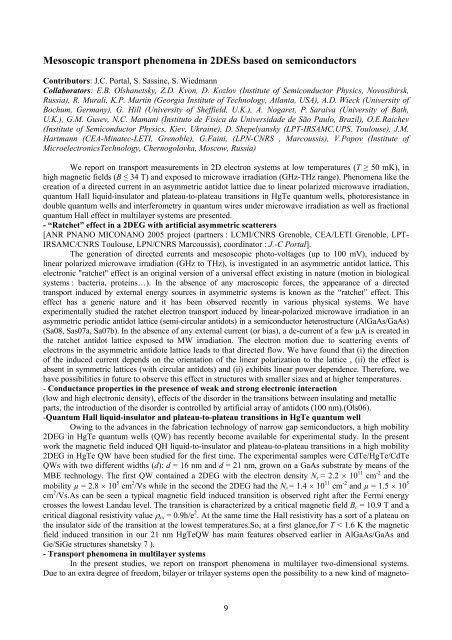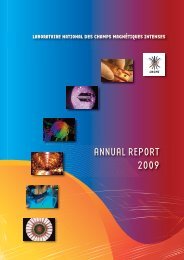Laboratoire National des Champs Magnétiques Pulsés CNRS – INSA
Laboratoire National des Champs Magnétiques Pulsés CNRS – INSA
Laboratoire National des Champs Magnétiques Pulsés CNRS – INSA
You also want an ePaper? Increase the reach of your titles
YUMPU automatically turns print PDFs into web optimized ePapers that Google loves.
Mesoscopic transport phenomena in 2DESs based on semiconductors<br />
Contributors: J.C. Portal, S. Sassine, S. Wiedmann<br />
Collaborators: E.B. Olshanetsky, Z.D. Kvon, D. Kozlov (Institute of Semiconductor Physics, Novosibirsk,<br />
Russia), R. Murali, K.P. Martin (Georgia Institute of Technology, Atlanta, USA), A.D. Wieck (University of<br />
Bochum, Germany), G. Hill (University of Sheffield, U.K.), A. Nogaret, P. Saraiva (University of Bath,<br />
U.K.), G.M. Gusev, N.C. Mamani (Instituto de Fisica da Universidade de São Paulo, Brazil), O.E.Raichev<br />
(Institute of Semiconductor Physics, Kiev, Ukraine), D. Shepelyansky (LPT-IRSAMC,UPS, Toulouse), J.M.<br />
Hartmann (CEA-Minatec-LETI, Grenoble), G.Faini, (LPN-<strong>CNRS</strong> , Marcoussis), V.Popov (Institute of<br />
MicroelectronicsTechnology, Chernogolovka, Moscow, Russia)<br />
We report on transport measurements in 2D electron systems at low temperatures (T ≥ 50 mK), in<br />
high magnetic fields (B ≤ 34 T) and exposed to microwave irradiation (GHz-THz range). Phenomena like the<br />
creation of a directed current in an asymmetric antidot lattice due to linear polarized microwave irradiation,<br />
quantum Hall liquid-insulator and plateau-to-plateau transitions in HgTe quantum wells, photoresistance in<br />
double quantum wells and interferometry in quantum wires under microwave irradiation as well as fractional<br />
quantum Hall effect in multilayer systems are presented.<br />
- “Ratchet” effect in a 2DEG with artificial asymmetric scatterers<br />
[ANR PNANO MICONANO 2005 project (partners : LCMI/<strong>CNRS</strong> Grenoble, CEA/LETI Grenoble, LPT-<br />
IRSAMC/<strong>CNRS</strong> Toulouse, LPN/<strong>CNRS</strong> Marcoussis), coordinator : J.-C Portal].<br />
The generation of directed currents and mesoscopic photo-voltages (up to 100 mV), induced by<br />
linear polarized microwave irradiation (GHz to THz), is investigated in an asymmetric antidot lattice. This<br />
electronic "ratchet" effect is an original version of a universal effect existing in nature (motion in biological<br />
systems : bacteria, proteins…). In the absence of any macroscopic forces, the appearance of a directed<br />
transport induced by external energy sources in asymmetric systems is known as the “ratchet” effect. This<br />
effect has a generic nature and it has been observed recently in various physical systems. We have<br />
experimentally studied the ratchet electron transport induced by linear-polarized microwave irradiation in an<br />
asymmetric periodic antidot lattice (semi-circular antidots) in a semiconductor heterostructure (AlGaAs/GaAs)<br />
(Sa08, Sas07a, Sa07b). In the absence of any external current (or bias), a dc-current of a few µA is created in<br />
the ratchet antidot lattice exposed to MW irradiation. The electron motion due to scattering events of<br />
electrons in the asymmetric antidote lattice leads to that directed flow. We have found that (i) the direction<br />
of the induced current depends on the orientation of the linear polarization to the lattice , (ii) the effect is<br />
absent in symmetric lattices (with circular antidots) and (ii) exhibits linear power dependence. Therefore, we<br />
have possibilities in future to observe this effect in structures with smaller sizes and at higher temperatures.<br />
- Conductance properties in the presence of weak and strong electronic interaction<br />
(low and high electronic density), effects of the disorder in the transitions between insulating and metallic<br />
parts, the introduction of the disorder is controlled by artificial array of antidots (100 nm).(Ols06).<br />
-Quantum Hall liquid-insulator and plateau-to-plateau transitions in HgTe quantum well<br />
Owing to the advances in the fabrication technology of narrow gap semiconductors, a high mobility<br />
2DEG in HgTe quantum wells (QW) has recently become available for experimental study. In the present<br />
work the magnetic field induced QH liquid-to-insulator and plateau-to-plateau transitions in a high mobility<br />
2DEG in HgTe QW have been studied for the first time. The experimental samples were CdTe/HgTe/CdTe<br />
QWs with two different widths (d): d = 16 nm and d = 21 nm, grown on a GaAs substrate by means of the<br />
MBE technology. The first QW contained a 2DEG with the electron density Ns = 2.2 × 10 11 cm -2 and the<br />
mobility µ = 2.8 × 10 5 cm 2 /Vs while in the second the 2DEG had the Ns = 1.4 × 10 11 cm -2 and µ = 1.5 × 10 5<br />
cm 2 /Vs.As can be seen a typical magnetic field induced transition is observed right after the Fermi energy<br />
crosses the lowest Landau level. The transition is characterized by a critical magnetic field Bc = 10.9 T and a<br />
critical diagonal resistivity value ρxx = 0.9h/e 2 . At the same time the Hall resistivity has a sort of a plateau on<br />
the insulator side of the transition at the lowest temperatures.So, at a first glance,for T < 1.6 K the magnetic<br />
field induced transition in our 21 nm HgTeQW has main features observed earlier in AlGaAs/GaAs and<br />
Ge/SiGe structures shanetsky 7 ).<br />
- Transport phenomena in multilayer systems<br />
In the present studies, we report on transport phenomena in multilayer two-dimensional systems.<br />
Due to an extra degree of freedom, bilayer or trilayer systems open the possibility to a new kind of magneto-<br />
9







